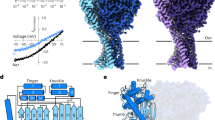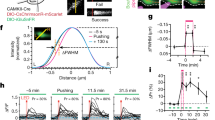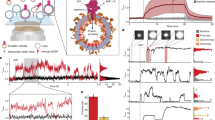Abstract
We have investigated the Ca2+ dependence of vesicular secretion from the soma of dorsal root ganglion (DRG) neurons, which secrete neuropeptides by exocytosis of dense-core vesicles. In patch-clamped somata of rat DRG neurons, we found a depolarization-induced membrane capacitance increase (ΔCm) in the absence of extracellular Ca2+ and in the presence of a Ca2+ chelator (BAPTA) in the intracellular solution. Depletion of internal Ca2+ stores by thapsigargin in the Ca2+-free bath also did not block the ΔCm, indicating that Ca2+ release from internal Ca2+ stores may not have been involved. Furthermore, the Ca2+-independent ΔCm was blocked by whole-cell dialysis with tetanus toxin and was accompanied by pulsatile secretion of false transmitters, as detected by amperometric measurements. These results indicate the existence of Ca2+-independent but voltage-dependent vesicular secretion (CIVDS) in a mammalian sensory neuron.
This is a preview of subscription content, access via your institution
Access options
Subscribe to this journal
Receive 12 print issues and online access
$209.00 per year
only $17.42 per issue
Buy this article
- Purchase on Springer Link
- Instant access to full article PDF
Prices may be subject to local taxes which are calculated during checkout








Similar content being viewed by others
References
Katz, B. The Release of Neural Transmitter Substances (Thomas, Springfield, Illinois, 1969).
Zhang, X., Aman, K. & Hokfelt, T. Secretory pathways of neuropeptides in rat lumbar dorsal root ganglion neurons and effects of peripheral axotomy. J. Comp. Neurol. 352, 481–500 (1995).
Huang, L. Y. & Neher, E. Ca2+-dependent exocytosis in the somata of dorsal root ganglion neurons. Neuron 17, 135–145 (1996).
Zhou, Z. & Misler, S. Action potential-induced quantal secretion of catecholamines from rat adrenal chromaffin cells. J. Biol. Chem. 270, 3498–3505 (1995).
Chow, R. H., Klingauf, J., Heinemann, C., Zucker, R. S. & Neher, E. Mechanisms determining the time course of secretion in neuroendocrine cells. Neuron 16, 369–376 (1996).
Bers, D. M. Excitation-Contraction Coupling and Cardiac Contractile Force (Kluwer Academic Publishers, Dordrecht, 1991).
Neher, E. Concentration profiles of intracellular calcium in the presence of a diffusible chelator. Exp. Brain Res. 14, 80–96 (1986).
Mosar, T. & Beutner, D. Kinetics of exocytosis and endocytosis of the cochlear inner hair cell afferent synapse of the mouse. Proc. Natl. Acad. Sci. USA 97, 883–888 (2000).
Sun, J. Y. & Wu, L. G. Fast kinetics of exocytosis revealed by simultaneous measurements of presynaptic capacitance and postsynaptic currents at a central synapse. Neuron 30, 171–182 (2001).
Xu, T., Binz, T., Niemann, H. & Neher, E. Multiple kinetic components of exocytosis distinguished by neurotoxin sensitivity. Nat. Neurosci. 1, 192–200 (1998).
Horrigan, F. T. & Bookman, R. J. Releasable pools and the kinetics of exocytosis in adrenal chromaffin cells. Neuron 13, 1119–1129 (1994).
Wightman, R. M. et al. Temporally resolved catecholamine spikes correspond to single vesicle release from individual chromaffin cells. Proc. Natl. Acad. Sci. USA 88, 10754–10758 (1991).
Jaffe, E. H., Marty, A., Schulte, A. & Chow, R. H. Extrasynaptic vesicular transmitter release from the somata of substantia nigra neurons in rat midbrain slices. J. Neurosci. 18, 3548–3553 (1998).
Puopolo, M., Hochstetler, S. E., Gustincich, S., Wightman, R. M. & Raviola, E. Extrasynaptic release of dopamine in a retinal neuron: activity dependence and transmitter modulation. Neuron 30, 211–225 (2001).
Zhou, Z. & Misler, S. Amperometric detection of stimulus-induced quantal release of catecholamines from cultured superior cervical ganglion neurons. Proc. Natl. Acad. Sci. USA 92, 6938–6942 (1995).
Zhou, Z. & Misler, S. Amperometric detection of quantal secretion from patch-clamped rat pancreatic beta cells. J. Biol. Chem. 271, 270–277 (1996).
Kim, K. T., Koh, D. S. & Hille, B. Loading of oxidizable transmitters into secretory vesicles permits carbon-fiber amperometry. J. Neurosci. 20, RC101 (2000).
Gillis, K. D., Mossner, R. & Neher, E. Protein kinase C enhances exocytosis from chromaffin cells by increasing the size of the readily releasable pool of secretory granules. Neuron 16, 1209–1220 (1996).
Matthews, G. Neurotransmitter release. Annu. Rev. Neurosci. 19, 219–233 (1996).
Smith, C., Moser, T., Xu, T. & Neher, E. Cytosolic Ca2+ acts by two separate pathways to modulate the supply of release-competent vesicles in chromaffin cells. Neuron 20, 1243–1253 (1998).
Mulkey, R. M. & Zucker, R. S. Action potentials must admit calcium to evoke transmitter release. Nature 350, 153–155 (1991).
Parnas, H., Segel, L., Dudel, J. & Parnas, I. Auto receptors, membrane potential and the regulation of transmitter release. Trends Neurosci. 23, 60–68 (2000).
Hu, H. Z. & Li, Z. W. Modulation by adenosine of GABA-activated current in rat dorsal root ganglion neurons. J. Physiol. 501, 67–75 (1997).
Xu, G. Y., Huang, L. Y. & Zhao, Z. Q. Activation of silent mechanoreceptive cat C and A δ sensory neurons and their substance P expression following peripheral inflammation. J. Physiol. 528, 339–348 (2000).
Ding, J. P., Li, Z. W. & Lingle, C. J. Inactivating BK channels in rat chromaffin cells may arise from heteromultimeric assembly of distinct inactivation-competent and noninactivating subunits. Biophys. J. 74, 268–289 (1998).
Gillis, K. D. Techniques for membrane capacitance measurements. in Single Channel Recording 2nd edn. (eds. Sakmann, B. & Neher, E.) 155–198 (Plenum, New York, 1995).
Zhou, Z. & Neher, E. Mobile and immobile calcium buffers in bovine adrenal chromaffin cells. J. Physiol. 469, 245–273 (1993).
You, Z. D., Li, J. H., Song, C. Y., Wang, C. H. & Lu, C. L. Chronic morphine treatment inhibits oxytocin synthesis in rats. Neuroreport 11, 3113–3116 (2000).
Acknowledgements
We thank L.C. Wang and W. Xiong for cell preparations and help with some experiments; Z.D. You for CGRP radioimmunoassay; T. Xu for advice and the gift of TeNT; and M.M. Poo, E. Neher, R.H. Chow and Y.Z. Wang for helpful comments on the manuscript. This work was supported by grants from Major State Basic Research Program of P.R. China (G2000077800), National Natural Science Foundation of China (39525009, 39970238, 39970371), Chinese Academy of Sciences and The Li Foundation (San Francisco).
Author information
Authors and Affiliations
Corresponding author
Ethics declarations
Competing interests
The authors declare no competing financial interests.
Rights and permissions
About this article
Cite this article
Zhang, C., Zhou, Z. Ca2+-independent but voltage-dependent secretion in mammalian dorsal root ganglion neurons. Nat Neurosci 5, 425–430 (2002). https://doi.org/10.1038/nn845
Received:
Accepted:
Published:
Issue Date:
DOI: https://doi.org/10.1038/nn845
This article is cited by
-
Stronger stimulus triggers synaptic transmission faster through earlier started action potential
Cell Communication and Signaling (2024)
-
Transcriptomics analysis reveals new insights in E171-induced molecular alterations in a mouse model of colon cancer
Scientific Reports (2018)
-
Gold nanoclusters-assisted delivery of NGF siRNA for effective treatment of pancreatic cancer
Nature Communications (2017)
-
Calcium influx activates adenylyl cyclase 8 for sustained insulin secretion in rat pancreatic beta cells
Diabetologia (2015)
-
Inhibition of Tetrodotoxin-Resistant Sodium Current in Dorsal Root Ganglia Neurons Mediated by D1/D5 Dopamine Receptors
Molecular Pain (2013)



